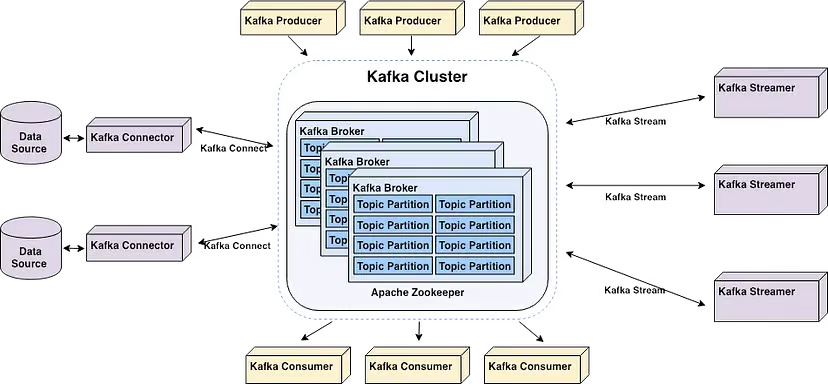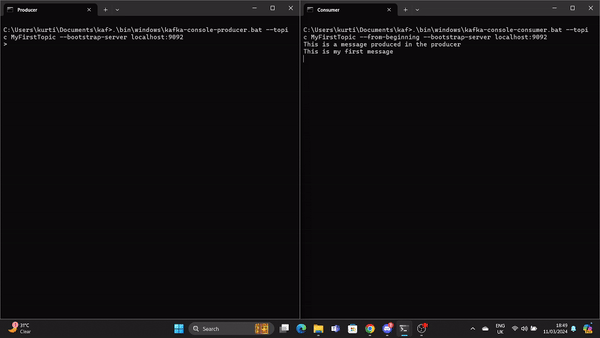Programa
El panorama de las aplicaciones modernas se ha transformado completamente con los microservicios y las arquitecturas de aplicaciones basadas en eventos. Los días del procesamiento por lotes han pasado a la historia. Para satisfacer las exigencias de velocidad y disponibilidad, los desarrolladores buscan una puntualidad casi real y una arquitectura de aplicaciones totalmente desacoplada.
Las aplicaciones desacopladas suelen utilizar un sistema de gestión de eventos para facilitar la integración entre distintos servicios. Otra aplicación de un almacén de eventos es en las arquitecturas basadas en fuentes de eventos, donde toda la lógica de la aplicación se expresa en términos de eventos. Aquí es donde Apache Kafka entra en la discusión.
Apache Kafka es un marco distribuido de flujo de eventos de código abierto desarrollado en LinkedIn por un equipo que incluía a Jay Kreps, Jun Rao y Neha Narkhede. La herramienta fue optimizada para ingerir y procesar datos en streaming en tiempo real; por tanto, puede utilizarse para implementar canalizaciones de datos de alto rendimiento, aplicaciones de análisis en streaming y servicios de integración de datos.
Esencialmente, Kafka es un marco para almacenes de eventos distribuidos y procesamiento de flujos que puede utilizarse como corredor de mensajes, almacén de eventos, sistema de gestión de colas, etc. Puedes leer nuestra comparación de Kafka frente a Amazon SQS en una guía aparte y comprobar cómo funcionan las Particiones de Kafka en nuestro tutorial.
¿Por qué Kafka?
Tras almacenar los eventos, la plataforma de streaming de eventos los dirige a los servicios pertinentes. Los desarrolladores pueden escalar y mantener un sistema como éste sin depender de otros servicios. Dado que Kafka es un paquete todo en uno que puede utilizarse como intermediario de mensajes, almacén de eventos o marco de procesamiento de flujos, funciona de forma excelente para este tipo de requisitos.
Con un alto rendimiento y durabilidad, cientos de fuentes de datos pueden proporcionar simultáneamente enormes flujos de datos continuos que pueden ser procesados secuencial y progresivamente por el sistema de corredor de mensajes de Apache Kafka.
Además, las ventajas de Apache Kafka incluyen:
Alto rendimiento
La arquitectura bien diseñada de Kafka, que incluye partición de datos, procesamiento por lotes, técnicas de copia cero y registros de sólo apéndice, le permite alcanzar un alto rendimiento y manejar millones de mensajes por segundo, atendiendo a escenarios de datos de alta velocidad y volumen. Así, el protocolo de comunicación ligero que facilita la interacción eficaz cliente-agente hace factible el flujo de datos en tiempo real.
Escalabilidad
Apache Kafka proporciona equilibrio de carga entre servidores particionando un tema en varias particiones. Esto permite a los usuarios distribuir los clusters de producción entre áreas geográficas o zonas de disponibilidad y ampliarlos o reducirlos según sus necesidades. En otras palabras, Apache Kafka puede ampliarse fácilmente para gestionar billones de mensajes al día en un gran número de particiones.
Baja latencia
Apache Kafka utiliza un clúster de servidores con baja latencia (tan baja como 2 milisegundos) para entregar mensajes de forma eficiente a un rendimiento limitado de la red, desacoplando flujos de datos.
Durabilidad y fiabilidad
Apache Kafka mejora la tolerancia a fallos y la durabilidad de los datos de dos formas fundamentales:
- Distribuye el almacenamiento de flujos de datos en un clúster tolerante a fallos para protegerse de los fallos del servidor
- Guarda los mensajes en disco y ofrece replicación intra-clúster.
Alta disponibilidad
Gracias a sus intermediarios basados en clústeres, Kafka permanece operativo durante una interrupción del servidor. Esto funciona porque cuando uno de los servidores experimenta problemas, Kafka es lo suficientemente inteligente como para enviar consultas a distintos intermediarios.
Conviértete en Ingeniero de Datos
Componentes básicos de Kafka
Apache Kafka permite a los usuarios analizar datos en tiempo real, almacenar registros en el orden en que fueron creados, y publicar y suscribirse a ellos.

Los componentes principales de Apache Kafka | Fuente: Inicia tu pipeline en tiempo real con Apache Kafka por Alex Kam
Apache Kafka es un clúster de servidores básicos escalable horizontalmente que procesa datos en tiempo real de múltiples sistemas y aplicaciones "productores" (por ejemplo, aplicaciones de registro, monitorización, sensores e Internet de las Cosas) y los pone a disposición de múltiples sistemas y aplicaciones "consumidores" (por ejemplo, análisis en tiempo real) con una latencia muy baja, como se muestra en el diagrama anterior.
Ten en cuenta que tanto las aplicaciones que dependen del procesamiento de datos en tiempo real como los sistemas de análisis pueden considerarse consumidores. Por ejemplo, una aplicación de micromarketing o logística basada en la localización.
He aquí algunos términos clave que debes conocer para comprender mejor los componentes básicos de Kafka:
- Los intermediarios son servidores del clúster que almacenan datos y sirven a los clientes.
- Los temas son categorías o feeds en los que se publican los registros. Ten en cuenta que hay dos tipos de temas: compactados y regulares. Los registros almacenados en temas compactados no están limitados por el tiempo o el espacio. Los mensajes de temas más antiguos con la misma clave se actualizan con mensajes más nuevos, y Apache Kafka no elimina el mensaje más reciente a menos que lo haga el usuario. En cambio, los registros almacenados en temas habituales pueden configurarse para que caduquen, lo que permite eliminar los datos obsoletos, liberando espacio de almacenamiento.
- Los productores son aplicaciones cliente que publican (escriben) eventos en temas Kafka.
- Los consumidores son aplicaciones que leen y procesan eventos de temas Kafka. Se pueden escribir programas Java que recuperen datos de Topics y devuelvan resultados a Apache Kafka gracias a la API de Streams para Apache Kafka. Los sistemas externos de procesamiento de flujos, como Apache Spark, Apache Apex, Apache Flink, Apache NiFi y Apache Storm, también pueden procesar estos flujos de mensajes.
- Kafka utiliza una biblioteca cliente llamada "Streams" para crear microservicios y aplicaciones donde los datos se almacenan en clusters para entrada y salida.
Primeros pasos con Kafka
A menudo se recomienda iniciar Apache Kafka con Zookeeper para una compatibilidad óptima. Además, Kafka puede encontrarse con varios problemas cuando se instala en Windows porque no está diseñado de forma nativa para su uso con este sistema operativo. En consecuencia, se aconseja utilizar lo siguiente para lanzar Apache Kafka en Windows:
- WSL2 si utilizas Windows 10 o posterior, o Docker
- Docker Si utilizas Windows 8 o anterior
No se aconseja utilizar la JVM para ejecutar Kafka en Windows, ya que no tiene algunas de las características POSIX propias de Linux. Al final encontrarás dificultades si intentas ejecutar Kafka en Windows sin WSL2.
Dicho esto, el primer paso para instalar Apache Kafka en Windows es instalar WSL2.
Paso 1: Instalar WSL2
WSL2, o Subsistema Windows para Linux 2, da acceso a tu PC Windows a un entorno Linux sin necesidad de una máquina virtual.
La mayoría de los comandos de Linux son compatibles con WSL2, lo que acerca el proceso de instalación de Kafka a las instrucciones ofrecidas para Mac y Linux.
Consejo: Asegúrate de que estás ejecutando Windows 10 versión 2004 o superior (Build 19041 y superior) antes de instalar WSL2. Pulsa la tecla del logotipo de Windows + R, escribe "winver" y haz clic en Aceptar para ver tu versión de Windows.
La forma más sencilla de instalar el Subsistema de Windows para Linux (WSL) es ejecutando el siguiente comando en un PowerShell de administrador o en el Símbolo del sistema de Windows y, a continuación, reiniciando el ordenador:
wsl --installTen en cuenta que se te pedirá que crees una cuenta de usuario y una contraseña para la distribución de Linux que acabas de instalar.
Sigue los pasos del sitio web de Microsoft Docs si te quedas atascado.
Paso 2: Instalar Java
Si Java no está instalado en tu máquina, tendrás que descargar la última versión.
Paso 3: Instalar Apache Kafka
En el momento de escribir este artículo, la última versión estable de Apache Kafka es la 3.7.0, publicada el 27 de febrero de 2024. Esto puede cambiar en cualquier momento. Para asegurarte de que utilizas la versión más actualizada y estable de Kafka, consulta la página de descargas.
Descarga la última versión desde Descargas binarias.
Una vez finalizada la descarga, navega hasta la carpeta donde se descargó Kafka y extrae todos los archivos de la carpeta comprimida. Observa que hemos llamado a nuestra nueva carpeta "Kafka".
Paso 3: Iniciar Zookeeper
Zookeeper es necesario para la gestión de clusters en Apache Kafka. Por lo tanto, Zookeeper debe lanzarse antes que Kafka. No es necesario instalar Zookeeper por separado porque forma parte de Apache Kafka.
Abre el símbolo del sistema y navega hasta el directorio raíz de Kafka. Una vez allí, ejecuta el siguiente comando para iniciar Zookeeper:
.\bin\windows\zookeeper-server-start.bat .\config\zookeeper.propertiesComienza 4: Iniciar el servidor Kafka
Abre otro símbolo del sistema y ejecuta el siguiente comando desde la raíz de Apache Kafka para iniciar Apache Kafka:
.\bin\windows\kafka-server-start.bat .\config\server.propertiesPaso 5: Crear un tema
Para crear un tema, inicia un nuevo símbolo del sistema desde el directorio raíz de Kafka y ejecuta el siguiente comando:
.\bin\windows\kafka-topics.bat --create --topic MyFirstTopic --bootstrap-server localhost:9092Esto creará un nuevo tema Kafka llamado "MiPrimerTema".
Nota: para confirmar que se ha creado correctamente, al ejecutar el comando aparecerá "Crear tema <nombre del tema>".
Paso 6: Iniciar Productor Kafka
Debe iniciarse un productor para poner un mensaje en el tema Kafka. Ejecuta el siguiente comando para hacerlo:
.\bin\windows\kafka-console-producer.bat --topic MyFirstTopic --bootstrap-server localhost:9092Paso 7: Iniciar consumidor Kafka
Abre otro símbolo del sistema desde el directorio raíz de Kafka y ejecuta el siguiente comando para enviar a stat el consumidor de Kafka:
.\bin\windows\kafka-console-consumer.bat --topic MyFirstTopic --from-beginning --bootstrap-server localhost:9092Ahora, cuando se produce un mensaje en el Productor, el Consumidor lo lee en tiempo real.

Un GIF muestra un mensaje producido por el Productor y leído por el Consumidor Kafka en tiempo real.
Ahí lo tienes... Acabas de crear tu primer tema Kafka.
Funciones avanzadas de Kafka
Aquí tienes algunas funciones avanzadas de Kafka...
Kafka Streams
Con Apache Kafka, los desarrolladores pueden crear sólidas aplicaciones de procesamiento de flujos con la ayuda de Kafka Streams. Ofrece API y un Lenguaje Específico de Dominio (DSL) de alto nivel para manejar, convertir y evaluar flujos continuos de datos.
Algunas características clave son:
Tratamiento de flujos
El procesamiento en tiempo real de flujos de registros es posible gracias a Kafka Streams. Te permite recibir datos de temas Kafka, procesarlos y transformarlos, y luego devolver la información procesada a los temas Kafka. El procesamiento de flujos permite el análisis, la supervisión y el enriquecimiento de datos casi en tiempo real. Puede aplicarse a grabaciones individuales o a agregaciones con ventanas.
Procesamiento en tiempo real
Utilizando las marcas de tiempo adjuntas a los registros, puedes manejar registros fuera de orden con el soporte de Kafka Streams para el procesamiento de eventos en tiempo real. Proporciona operaciones de ventana con semántica de tiempo de evento, permitiendo la unión de ventanas, la sesionización y las agregaciones basadas en el tiempo.
Operaciones basadas en el tiempo y ventanas
Kafka Streams proporciona una serie de operaciones de ventana que permiten a los usuarios realizar cálculos sobre ventanas de sesión, ventanas giratorias, ventanas deslizantes y ventanas de tiempo fijo.
Los disparadores basados en eventos, los análisis sensibles al tiempo y las agregaciones basadas en el tiempo son posibles mediante procedimientos de ventana.
Procesamiento por estados
Durante el procesamiento de flujos, Kafka Streams permite a los usuarios mantener y actualizar el estado. Se proporciona soporte integrado para almacenes estatales. Ten en cuenta que un almacén de estados es un almacén clave-valor que puede actualizarse y consultarse dentro de una topología de procesamiento.
Las funciones avanzadas de procesamiento de flujos, como las uniones, las agregaciones y la detección de anomalías, son posibles gracias a las operaciones con estado.
Procesamiento exactamente una vez
Kafka Streams proporciona una semántica de extremo a extremo para el procesamiento exactamente una vez, garantizando que cada registro se gestiona precisamente una vez, incluso en caso de fallo. Esto se consigue utilizando las sólidas garantías de durabilidad y las funciones transaccionales de Kafka.
Kafka Connect
El marco de integración de datos declarativo y conectable para Kafka se llama Kafka Connect. Es un componente gratuito y de código abierto de Apache Kafka que actúa como un concentrador de datos centralizado para la integración sencilla de datos entre sistemas de archivos, bases de datos, índices de búsqueda y almacenes de valores clave.
La distribución de Kafka incluye Kafka Connect por defecto. Para instalarlo, sólo tienes que iniciar un proceso obrero.
Utiliza el siguiente comando desde el directorio raíz de Kafka para lanzar el proceso de trabajador de Kafka Connect:
.\bin\windows\connect-distributed.bat
.\config\connect-distributed.propertiesEsto lanzará el trabajador de Kafka Connect en modo distribuido, permitiendo la alta disponibilidad y escalabilidad de ejecutar numerosos trabajadores en un clúster.
Nota: El archivo .\config\connect-distributed.properties especifica la información del broker de Kafka y otras propiedades de configuración para Kafka Connect.
Los conectores son utilizados por Kafka Connect para transferir datos entre sistemas externos y temas Kafka. Los conectores pueden instalarse y configurarse para adaptarse a tus requisitos exclusivos de integración de datos.
Descargar y añadir el archivo JAR del conector al directorio plugin.path mencionado en el archivo .\config\connect-distributed.properties es todo lo que se necesita para instalar un conector.
Hay que crear un archivo de configuración para el conector, en el que se especifique la clase del conector y cualquier otra característica. La API REST de Kafka Connect y las herramientas de línea de comandos pueden utilizarse para construir y mantener conectores.
A continuación, para combinar datos de otros sistemas, debes configurar el Conector Kafka. Kafka Connect ofrece varios conectores para integrar datos de diversos sistemas, como sistemas de archivos, colas de mensajes y bases de datos. Selecciona un conector en función de las necesidades de integración que tengas: consulta la documentación para ver la lista de conectores.
Aplicaciones reales de Kafka
He aquí algunos casos de uso común de Apache Kafka.
Seguimiento de la actividad
Una plataforma de comercio electrónico en línea puede utilizar Kafka para seguir la actividad de los usuarios en tiempo real. Cada acción del usuario, como ver productos, añadir artículos al carrito, comprar, dejar opiniones, hacer búsquedas, etc., puede publicarse como un evento en temas Kafka concretos.
Otros microservicios pueden almacenar o utilizar estos eventos para la detección de fraudes en tiempo real, informes, ofertas personalizadas y recomendaciones.
Mensajería
Con su rendimiento mejorado, partición incorporada, replicación, tolerancia a fallos y capacidades de escalado, Kafka es un buen sustituto de los corredores de mensajes convencionales.
Una aplicación de transporte basado en microservicios puede utilizarlo para facilitar el intercambio de mensajes entre varios servicios.
Por ejemplo, la empresa de reservas de viajes puede utilizar Kafka para comunicarse con el servicio de búsqueda de conductores cuando un conductor hace una reserva. El servicio de búsqueda de conductores puede entonces, casi en tiempo real, localizar a un conductor en la zona y responder con un mensaje.
Agregación de registros
Normalmente, esto implica obtener archivos de registro físicos de los servidores y almacenarlos en una ubicación central para su procesamiento, como un servidor de archivos o un lago de datos. Kafka abstrae los datos como un flujo de mensajes y filtra la información específica del archivo. Esto permite procesar los datos con una latencia reducida y adaptarse más fácilmente al consumo de datos distribuidos y a diferentes fuentes de datos.
Una vez publicados los registros en Kafka, una herramienta de análisis de registros o un sistema de gestión de eventos e información de seguridad (SIEM) pueden utilizarlos para solucionar problemas, supervisar la seguridad y elaborar informes de cumplimiento.
Tratamiento de flujos
Varios usuarios de Kafka procesan datos en pipelines de procesamiento multietapa. Los datos de entrada sin procesar se toman de temas Kafka, se agregan, se enriquecen o se transforman de otro modo en nuevos temas para su consumo o procesamiento adicional.
Por ejemplo, un banco puede utilizar Kafka para procesar transacciones en tiempo real. Cada transacción que inicia un cliente se publica en un tema Kafka como un evento. Posteriormente, una aplicación puede recoger estos eventos, verificar y gestionar las transacciones, detener las dudosas y actualizar instantáneamente los saldos de los clientes.
Métricas
Un proveedor de servicios en la nube podría utilizar Kafka para agregar estadísticas de aplicaciones distribuidas y generar flujos centralizados de datos operativos en tiempo real. Las métricas de cientos de servidores, como el consumo de CPU y memoria, el recuento de peticiones, las tasas de error, etc., podrían notificarse a Kafka. Las aplicaciones de monitorización podrían entonces utilizar estas métricas para la identificación de anomalías, alertas y visualización en tiempo real.
Conclusión
Kafka es un marco para el procesamiento de flujos que permite a las aplicaciones publicar, consumir y procesar grandes cantidades de flujos de registros de forma rápida y fiable. Teniendo en cuenta la creciente prevalencia del flujo de datos en tiempo real, se ha convertido en una herramienta vital para los desarrolladores de aplicaciones de datos.
En este artículo, cubrimos por qué uno puede decidir utilizar Kafka, los componentes básicos, cómo empezar a utilizarlo, las funciones avanzadas y las aplicaciones del mundo real. Para seguir aprendiendo, consulta
Certifícate en el puesto de Ingeniero de Datos de tus sueños
Nuestros programas de certificación te ayudan a destacar y a demostrar que tus aptitudes están preparadas para el trabajo a posibles empleadores.


